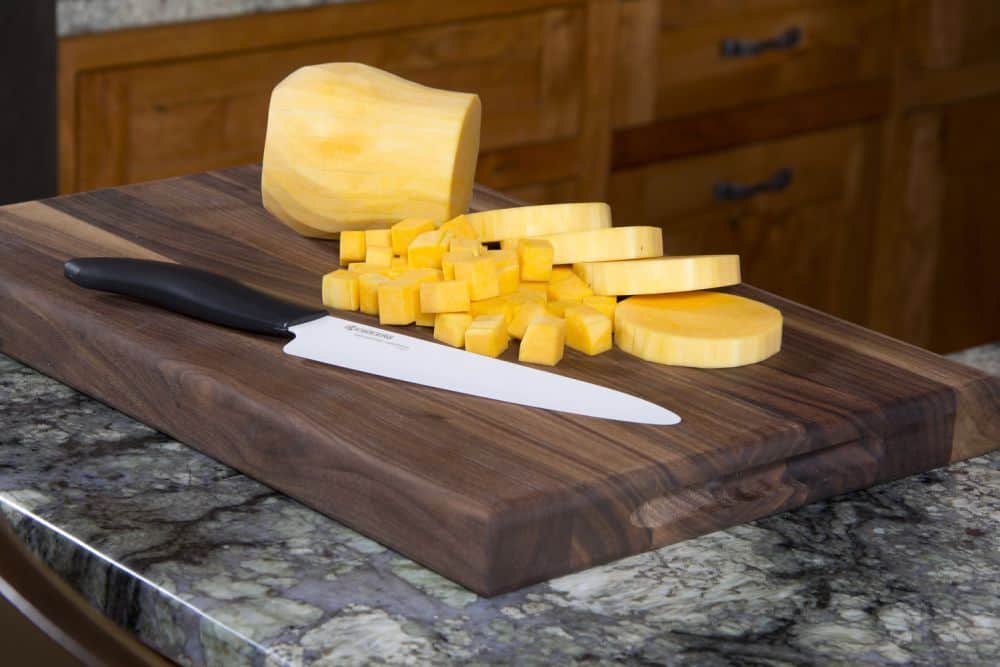
[Image above] The ceramic knife shown here is from Kyocera’s line of ceramic knives. Kyocera was one of the first companies to develop and market the zirconia ceramic knife. Credit: Didriks, Flickr (CC BY 2.0)
By Laurel Sheppard
Knives are one of the earliest tools used by humanity, with the oldest ones dating back nearly 2.5 million years. The materials used to create these sharp-edged tools, however, have undergone some significant advancements since those early days.
Initially, flint was widely used for creating knives, in addition to other hard stones, such as quartz. Bronze became more popular as its capabilities were realized, but iron eventually became the material of choice because, despite being inferior to bronze in terms of strength and sharpness, it could be easily mass produced.
When steel production took off in Germany and England during the 19th century, craftsmen started to make knives from this material. But it was the advancement of stainless steel in the 1920s that truly revolutionized the market, and today most kitchen knives are made from stainless steel.
Ceramic knives entered the picture in the late 20th century thanks largely to Japanese multinational ceramics and electronics manufacturer Kyocera Corporation. As explained in a Kyocera press release, the company produced and sold its first ceramic knife in 1984 after much research and development, including learning traditional blade sharpening techniques in the famed Japanese cutlery center of Gifu.
Mass production of Kyocera’s ceramic knives kicked off in 1987 with the filing of Japanese patent JP 2652020, which described a method to sharpen ceramic cutting tool blades. Another development in 2003, Japanese patent JP 3905062, described a unique rounded geometry for ceramic blade tips that enhances durability.
Kyocera’s ceramic knives are made from a proprietary ceramic called Zirconia 206, which is formed by compressing zirconium oxide along with some other advanced materials under many tons of pressure.
In 2022, Kyocera received its 34th patent for ceramic knife technology (JP 6151878, US 10118302 B2). Dubbed INNOVATIONblack, these knives maintain their sharpness twice as long as conventional ceramic blades by combining two types of ceramic materials with different hardness levels.
Kyocera is not the only company that produces ceramic knifes; other companies include Cuisinart, Victorinox, and Shenzhen Knives. Cuisinart’s knives are only coated with ceramic, so they may be less expensive than other all-ceramic brands. Some manufacturers mix in filler materials to reduce the cost or to create a more flexible blade, which can lower the cutting performance. The video below features some of the most popular ceramic knives that were available in 2023.
Compared to metal knives, ceramic knives are harder, more wear resistance, and lighter weight. Other benefits include
- Will not rust or chemically react with foods;
- Easy to clean with water and detergent;
- Lightweight (half that of steel);
- Will not give food a peculiar smell, which happens with metal;
- No oil coating or maintenance required;
- Blade is safe up to 1,600°C (~2,900°F); and
- Spark-resistant, nonconductive (electrical insulator), and nonmagnetic.
These benefits made ceramic knives popular with sushi chefs, according to Precision Ceramics USA, because they did not taint the fresh fish like some metal knives did. From there, ceramic knives gained popularity among home chefs as well.
The video below features a chef and cooking instructor explaining why he likes ceramic knives. He demonstrates how well these knives cut certain meats and vegetables, particularly tomatoes.
Of course, blade brittleness is the main disadvantage of ceramic knives. The blades can chip if used to cut through harder items, such as bones or frozen foods, and may break if dropped onto a hard surface. So, they should not be used for intense chopping, smashing, prying, or cutting purposes. Also, ceramic knives should not be used on metal, stone, or glass surfaces; plastic or wood cutting boards are best.
On the Precision Ceramics USA website, business director Geoff Randle commented that “From a personal point of view, I have used ceramic knives in my kitchen for about 10 years, and the 5-year-old knife I currently use has a number of small chips on the blade, mostly as a direct result of my mishandling and dropping of the knife.”
As with any blade, ceramic knives will require occasional sharpening. But sharpening ceramic knives requires different equipment than sharpening steel knives, as the video below demonstrates.
